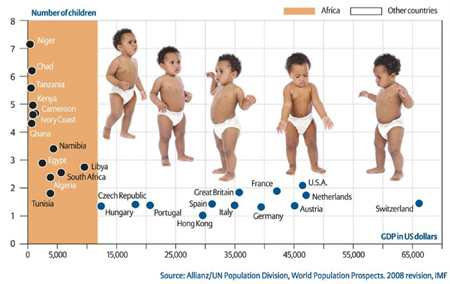What is the biggest world problem? Some would have you believe it is Climate Change; others might say Iran, China, and/or North Korea, while others will cite Russia or corruption/dissention in our capital. Yes, those are all problems with the exception, in my opinion, of “climate change” which used to be labeled “global warming” but is simply – WEATHER.
No, none of these IS the biggest problems our world faces today. The biggest problem we face is genuine, serious, and impacting our world in dire ways and has implications for the future that make all those other problems pale in comparison. And, it’s happening right in YOUR bedroom.
We are NOT making enough babies in many parts of the world. Yes, we are not reproducing nearly enough to sustain human life in many parts of the world. A de-mystifying statistic that is a poke-in-the-eye to those population growth fear mongers is sadly revealing: Japan now sells more adult diapers than baby ones!
Further, if you took the entire world’s population and divided it into family groups of four, the entire world could live in Texas.
“So how much land would we need to house all 7 billion of us…Upon examining the U.S., we find out that Texas has 261,797 square miles of land…Which is, in fact, more than the area we need to house all 7 billion of us at typical New York City densities. Meaning every man, woman, and child living and breathing on the face of the Earth could fit in relative comfort within the land territory of the State of Texas.”
“The other 49 states: empty. Canada? A wasteland as empty as the northern extremes of Nunavut. Europe? Empty. Asia? Nobody home. Africa, Australia, South and Central America, all the islands? None left. The entire world outside of Texas contains not a single living, breathing person.” Or, as I like to describe this fantasy, the entire world lives in Texas and the rest of the entire world is our farm and playground!
“…Every person in the world could live inside of Texas without overcrowding. We could all have water with just the Columbia River alone. And we could easily feed ourselves with just the farmland within the US as it exists.”
“Now that we have the numbers, are we really overpopulated? I would argue a resounding “NO” and I think any who say otherwise are simply not adding it up.” ~ The Overpopulation Myth
What an amazing idea? Clearly, the issue is not too many people but too much poor management of our mutual natural resources. In the United States, we have enough energy to completely be independent but the green-movement and extreme environmentalists regulate us into stagnation and worse. As for food, we cured malaria until those same environmentalists worked to ban DDT and other pesticides that killed malaria-carrying mosquitoes, thus CAUSING the revival of that horrible disease and killing literally millions.
We have a pipeline designed and ready to go, but it’s being held up by these same wackos and is taking longer to get approved than the entire time it took to prosecute World War II! No, we don’t have an over-population problem – we have a political one.
“…According to experts’ best estimates, the total population of Earth will stop growing within the lifespan of people alive today.”
“In Germany, the birthrate has sunk to just 1.36, worse than its low-fertility neighbors Spain (1.48) and Italy (1.4). The way things are going, Western Europe as a whole will most likely shrink from 460 million to just 350 million by the end of the century. That’s not so bad compared with Russia and China, each of whose population could fall by half.” Note from author: to stay exactly break-even with population, statistically every woman must have at least 2 children, assuming all babies live, so practically the break-even point is slightly above 2.
“American media have largely ignored the issue of population decline for the simple reason that it hasn’t happened here yet.”
“From 1960 to 2009, Mexico’s fertility rate tumbled from 7.3 live births per woman to 2.4, India’s dropped from 6 to 2.5, and Brazil’s fell from 6.15 to 1.9. Even in sub-Saharan Africa, where the average birthrate remains a relatively blistering 4.66, fertility is projected to fall below replacement level by the 2070s. This change in developing countries will affect not only the U.S. population, of course, but eventually the world’s” ~ Slate
The CIA puts out something called The World Factbook in which there’s a page comparing the fertility rates of all 224 countries in the world. Who is where is quite illuminating. Among the top baby-making countries projected for 2014, most are in Africa. Singapore is LAST at #224. Japan is #208. The United States is #123 with a projected fertility rate of 2.01. That’s barely staying even and that is assuming every baby lives! You’ll be relieved to know the top three: Niger, Mali, and Burundi all with rates above 6.0.
”Already, more than half the world’s population is reproducing at below the replacement rate.”
“And in the long term—on the order of centuries—we could be looking at the literal extinction of humanity.”
“According to a 2008 IIASA report, if the world stabilizes at a total fertility rate of 1.5—where Europe is today—then by 2200 the global population will fall to half of what it is today. By 2300, it’ll barely scratch 1 billion (The authors of the report tell me that in the years since the initial publication, some details have changed—Europe’s population is falling faster than was previously anticipated, while Africa’s birthrate is declining more slowly—but the overall outlook is the same). Extend the trend line, and within a few dozen generations you’re talking about a global population small enough to fit in a nursing home.”
“Singapore has been encouraging parenthood for nearly 30 years, with cash incentives of up to $18,000 per child. Its birthrate? A gasping-for-air 1.2. When Sweden started offering parents generous support, the birthrate soared but then fell back again, and after years of fluctuating, it now stands at 1.9 — very high for Europe but still below replacement level.”
“In developed countries, childrearing has become a lifestyle option tailored to each couple’s preferences. Maximizing fertility is rarely a priority.” ~ Slate







